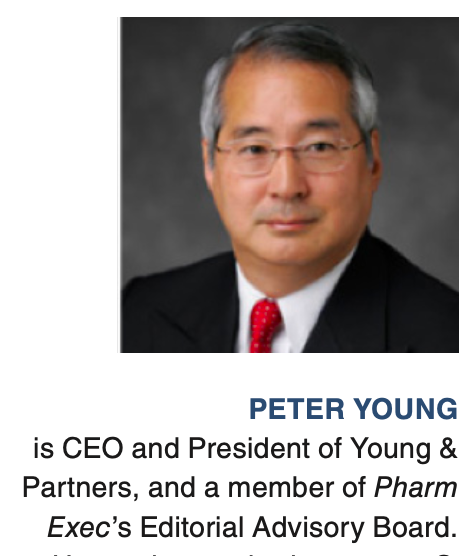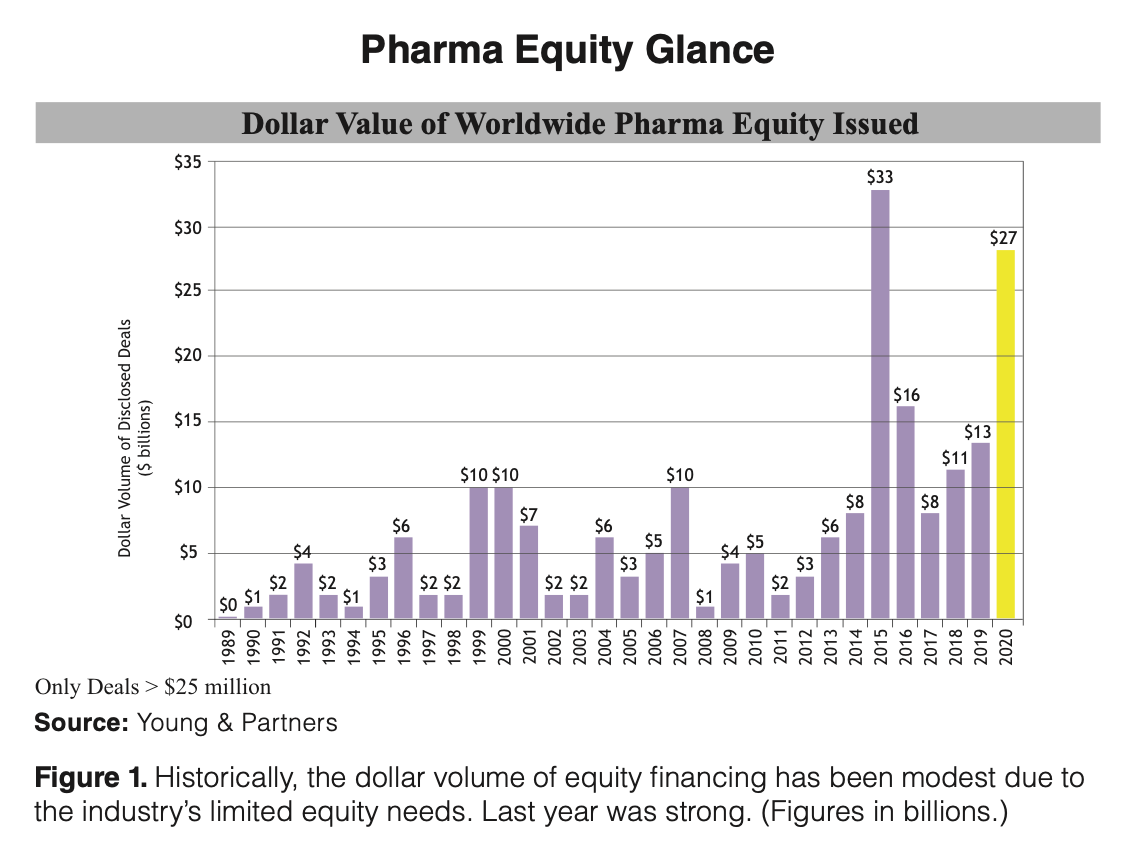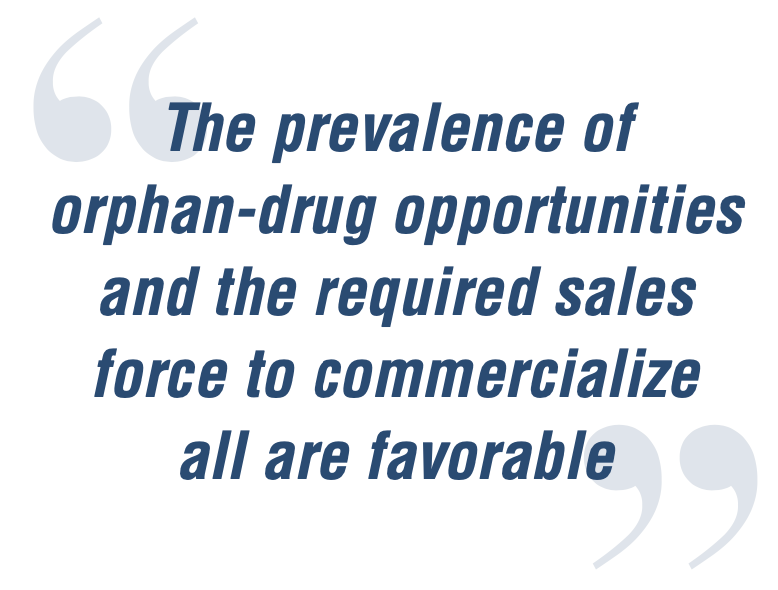Pharma and Biotech’s 2020 Full-Year View
Examining the key biopharma stock numbers and industry trends from a year that challenged the conduct of business and market stability like never before.

It was both an exciting and a challenging year for the pharmaceutical and biotechnology industries in 2020—and continuing so in 2021.
On the positive side, the COVID-19 pandemic is showing a global audience that the biopharma industry serves a critical role in finding solutions to the current crisis, whether it is vaccines, cures, or drugs to reduce the severity of the disease for those who are infected. This is serving to blunt some of the very negative press that the industry has been subject to over pricing and other issues. Other positives include the new technologies that have been invented and the increasing number of new drugs approved and under development by pharma and biotech companies.
The emergence of a host of new methods, such as immuno-oncology, CRISPR, personalized medicine, and stem cells has been exciting, albeit with the normal periodic setbacks such as the one we are seeing in CRISPR. In addition, there have been many proposed and implemented changes in US FDA, Chinese FDA, and European Medicines Agency (EMA) policies with regard to drug approvals that are favorable. Time will tell if the actual results match the intent.
The industry has been rewarded with much stronger stock market valuations than many other industries. As a consequence, biotech companies have been able to raise considerable equity capital through private placements, IPOs, and secondary public offerings.
But the challenges are also visible as well. For pharma companies, the pandemic has had a significant impact on the availability of many drugs, the disruption of supply chains, and the ability to conduct clinical trials when so many people are sheltering at home and hospitals are forced to devote their resources toward the treatment of COVID-19 patients and less toward clinical trial activities and research. Other challenges include the relentlessly high cost of drug development, controversies around pricing, the scrutiny of orphan-drug pricing, lower profitability relative to history, increasing price and formulary pressure from payers, weak pricing leverage outside the US, and structural changes in healthcare and government policies in large countries such as the US and China that are impacting pharma companies. Biotech organizations are facing some of the same challenges.
The rest of this article will look at what happened from an M&A, stock market, and financing point of view in 2020 and what we expect in 2021 and beyond. We will also comment on the implications of these trends for senior executives and investor decisions in the pharma and biotech sectors.
Pharma equity market performance
During the first half of 2020, global equity markets saw major declines followed in the second half by partial or full recoveries in direct response to the coronavirus pandemic and the market’s assessment of what the relative returns are in different investment classes and locations.
By year end, the S&P 500 had increased 15.3% and the S&P Euro 350 had decreased by 6.2%.
The overall picture for the pharma industry was positive but varied by segment and geography.
The Y&P US BioPharma index increased by 7.1% , the European BioPharma index rose by 1.3%, and the Y&P Generic Pharma index increased by 28.1%.
In terms of P/E ratios, the US biopharma company average dropped, the European bioparma company average gained modestly, and the generic pharma company average fell.
Hence, the overall stock market performance was positive, but valuation trends were mixed.
Pharma equity financing and M&A
Equity issuance in 2020 surged. Equity issuance dollar volume totaled $27.2 billion versus $12.6 billion for all of 2019.
The primary drivers of volume were Sanofi selling a large stake in Regeneron Pharmaceuticals, Inc. and Amgen Inc. purchasing a large stake in BeiGene, Ltd.

Although the number of M&A deals increased in 2020, the dollar volume and the average deal size fell considerably. Last year, 25 deals were completed worth $109.1 billion versus 21 deals completed worth $172.9 billion in 2019.
In addition, one dealmade up the majority of the dollar volume, with the acquisition of Allergan plc by AbbVie Inc. accounting for $62.3 billion of the total.
The pipeline of deals was modest as well. As of Dec. 31, 2020, the deals announced but not closed was $43.7 billion (five deals), the largest of which dominated the dollar total: AstraZeneca’s $43.3 billion purchase of Alexion.
Clearly, there are fewer large deals as the industry is focused on biotech acquisitions instead of pharma deals and on partnering and companies’ own drug development. There is also the recognition that mega deals may have presented cost-reduction synergies, but they have often been disappointing from a product portfolio and drug development standpoint.
Of course, the start of the pandemic also was a disrupter of the M&A market as companies had to focus their attention on their operations, shifting many workers from their offices to their homes, and supply chain disruptions, etc.
Biotech equity market performance
As we indicated earlier, the overall equity markets dropped early in 2020 and subsequently recovered strongly. The Y&P Biotech Mid-Small Cap index performed even better, increasing by 101.1%.
The positive news about biotech drug development and the positive perception of the biopharma industry due to its role in dealing with the pandemic has created a strong story in the equity markets, despite the partial offset from the negative publicity about drug pricing, payer pushback against orphan-drug pricing, and the ongoing struggle to conduct and fund research and clinical trials.
Biotech equity financing and M&A
The big financial story in 2020 was the equity issuance market for biotech. There was a surge in equity offerings, with 375 equity offerings worth $55.3 billion in 2020 versus 224 offerings worth $23.8 billion in 2019. There was a similar surge in IPOs. Eighty-six IPOs were completed worth $16 billion. This compares to 56 IPOs worth $6.1 billion completed in 2019.
The equity markets fell heavily in love with the biotech sector as the positive sentiment and the numerous success stories—particularly with the M&A takeout deals in 2020—were strong drivers of investor interest.
Biotech M&A activity has been modest historically, with small spurts of activity from time to time. That was not as true in 2020. Last year, the number of deals was slightly higher compared to 2019, but the dollar volume surged massively to an all-time record level.
In 2020, 34 deals worth $53.3 billion were completed versus 32 deals worth $19 billion completed in all of 2019.
The dollar value of the pipeline of deals as of Dec. 31, 2020, was modest at $715.4 million (nine deals).
Heightened interest in and high prices being paid for biotech companies in certain segments by pharma organizations was a major factor. Not surprisingly, all of the buyers were large pharma.
Outlook: pharma
Business. The business outlook for pharma manufacturers is positive with regard to drug development, with promising products in the pipeline. The industry’s drug development innovation and productivity has been moderate. However, combined with indirect development through the biotech industry, overall development activity has been strong and should continue to be strong.
There has been a shift in emphasis toward orphan drugs, oncology therapies, new innovations such as gene therapy, CAR-T, immune system solutions, CRISPR, etc.
The current pandemic has been a plus for the reputation of the industry, but a negative with regard to the ability to execute clinical trials and the industry supply chains.
Generic pharma companies are under severe profit pressures and will continue to consolidate, cut costs, and try to push selectively into higher value and more protected product areas. They are under intense pricing and competitive pressure.
The stock market prices and valuations of the ethical pharma industry companies have been stable due to the net effect of the positive news for the industry during the pandemic, and the negative news around pricing and the ongoing R&D and commercial challenges of the industry. We think there will be a continued counterbalancing of the positive news versus the business challenges for the biopharma industry.
Equity markets. The stock market prices and valuations of the ethical pharma industry companies have weakened as the negative pressures on the industry continue, in spite of a mixture of R&D and commercial successes. It is our expectation that the negative news will continue to counterbalance the positive news for the biopharma industry.
Generic pharma company share prices have modestly rebounded, but they will continue to suffer as these companies deal with serious business issues/pressures.
Equity financing. We expect the equity financing market for pharma to be modest, but very healthy. The pharma industry tends not to raise new equity very often unless an individual company has to raise equity to repair its balance sheet after an acquisition.
M&A. Young & Partners expects M&A activity, with the exception of a handful of mega deals, to continue to be solid for the reasons mentioned because normal strategic fill-ins will continue, with much of the focus on medium-to-large deals. It is not clear if there will be any more mega deals in the near-to-medium term.
Even without mega deals, there will be plenty of large and medium-sized deals with a strategic rationale or a theme around adding new and growing technologies and therapeutic products being pursued.
Separately, pharma manufacturers are focused on acquiring biotech companies, which is affecting the biotech M&A volume. But pharma is also heavily pursuing in-licensing arrangements, partnerships, and joint ventures with biotechs and other pharmas.
Outlook: biotech

Business. The development capabilities of biotech companies have been and should continue to be positive overall. The ability to massively innovate continues to be an established trait of the biotech sector. The prevalence of orphan-drug opportunities that lower the time to approval, the clinical trial costs, and the required sales force to commercialize all are favorable for biotechs Although there will be successes and failures by individual companies, biotechs have demonstrated their ability to develop new drugs at a faster pace than the larger pharma companies. This trend will continue in 2021 and well beyond.
Equity markets. The stock market performance of biotech organizations was volatile but strong in 2020. We believe the prices will remain high and volatility will continue, with fluctuations driven by the likely volatile industry news.
The biotech industry is now in favor because these companies are less affected by the pandemic and their image has become more positive. We expect the positive view of the biopharma industry and the regular announcements of successful R&D discoveries and successful clinical trials will continue to fuel the positive stock market treatment of the biotech industry.
Equity financing. Biotech companies will continue to tap the equity markets at high rates in 2021 and beyond for both IPOs and secondary offerings. The biotech sector is clearly in favor. Of course, partnering, licensing, and royalty monetization for funding and for shareholder liquidity also exists.
M&A. M&A volume has been solid and will continue to be through 2021 and beyond. Much of the volume will be larger deals done by big pharma. Buyer interest will be focused on specific targets in favored therapeutic and technology areas and on biotech companies that have made significant clinical progress.
Implications for senior management
For ethical pharma companies, there will continue to be a wide variety of tools to acquire revenues and pipeline drugs, but the M&A valuations will continue to be challenging, particularly for companies with promising drugs in late-stage clinical trials or awating FDA approvals. The challenge will be to pick the right overall mix of M&A, licensing, and partnering to accomplish corporate strategic goals and defend and deliver shareholder value.
Generic pharma companies will continue to face a number of industry challenges. This will result in a continuation of the current industry consolidation and selective strategies around diversification. CEOs of the generic pharma companies must be prepared to shift to very different strategies to survive and to thrive.
For biotechs, public and private, the future is exciting from the drug development side in terms of the product approval environment and innovation and the improvement these companies have seen in the IPO, secondary equity financing, and M&A markets. However, prosperity or disappointment will vary. Unfortunately, the markets have been volatile and have played favorites with regard to therapies, technologies, and stages of development.
The key for biotech organizations will be to properly assess their cash flow requirements and to create and execute a flexible financing/M&A plan that properly assesses how much capital and at what cost of equity the various alternatives will provide, whether it is private placements, partnering, IPOs and secondary offerings, royalty monetizations, or sources of non-dilutive financing.
Peter Young is CEO and President of Young & Partners, and a member of PharmExec’s Editorial Advisory Board. He can be reached at pyoung@youngandpartners.com.

Regeneron, Roche Launch Major US Expansion Plans to Meet Growing Demand for Biologics and Innovation
April 22nd 2025With combined investments exceeding $53 billion, both companies are deepening their US presence through expanded biologics production, gene therapy capabilities, and next generation R&D centers.
The Misinformation Maze: Navigating Public Health in the Digital Age
March 11th 2025Jennifer Butler, chief commercial officer of Pleio, discusses misinformation's threat to public health, where patients are turning for trustworthy health information, the industry's pivot to peer-to-patient strategies to educate patients, and more.
Navigating Distrust: Pharma in the Age of Social Media
February 18th 2025Ian Baer, Founder and CEO of Sooth, discusses how the growing distrust in social media will impact industry marketing strategies and the relationships between pharmaceutical companies and the patients they aim to serve. He also explains dark social, how to combat misinformation, closing the trust gap, and more.